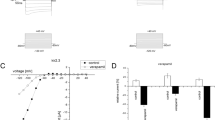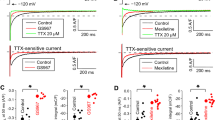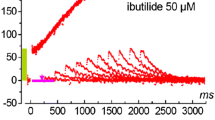Abstract.
Propafenone has been shown to affect the delayed-rectifier potassium currents in cardiomyocytes of different animal models. In this study we investigated effects and mechanisms of action of propafenone on HERG potassium channels in oocytes of Xenopus laevis with the two-electrode voltage-clamp technique.
Propafenone decreased the currents during voltage steps and the tail currents. The block was voltage-dependent and increased with positive going potentials (from 18% block of tail current amplitude at –40 mV to 69% at +40 mV with 100 µmol/l propafenone). The voltage dependence of block could be fitted with the sum of a monoexponential and a linear function. The fractional electrical distance was estimated to be δ=0.20. The block of current during the voltage step increased with time starting from a level of 83% of the control current. Propafenone accelerated the increase of current during the voltage step as well as the decay of tail currents (time constants of monoexponential fits decreased by 65% for the currents during the voltage step and by 37% for the tail currents with 100 µmol/l propafenone). The threshold concentration of propafenone effect was around 1 µmol/l and the concentration of half-maximal block (IC50) ranged between 13 µmol/l and 15 µmol/l for both current components. With high extracellular potassium concentrations, the IC50 value rose to 80 µmol/l. Acidification of the extracellular solution to pH 6.0 increased the IC50 value to 123 µmol/l, alkalization to pH 8.0 reduced it to 10 µmol/l and coexpression of the β-subunit minK had no statistically significant effect on the concentration dependence.
In conclusion, propafenone has been found to block HERG potassium channels. The data suggest that propafenone affects the channels in the open state and give some hints for an intracellular site of action.
Similar content being viewed by others
Author information
Authors and Affiliations
Additional information
Electronic Publication
Rights and permissions
About this article
Cite this article
Mergenthaler, J., Haverkamp, W., Hüttenhofer, A. et al. Blocking effects of the antiarrhythmic drug propafenone on the HERG potassium channel. Naunyn-Schmied Arch Pharmacol 363, 472–480 (2001). https://doi.org/10.1007/s002100000392
Received:
Accepted:
Issue Date:
DOI: https://doi.org/10.1007/s002100000392




